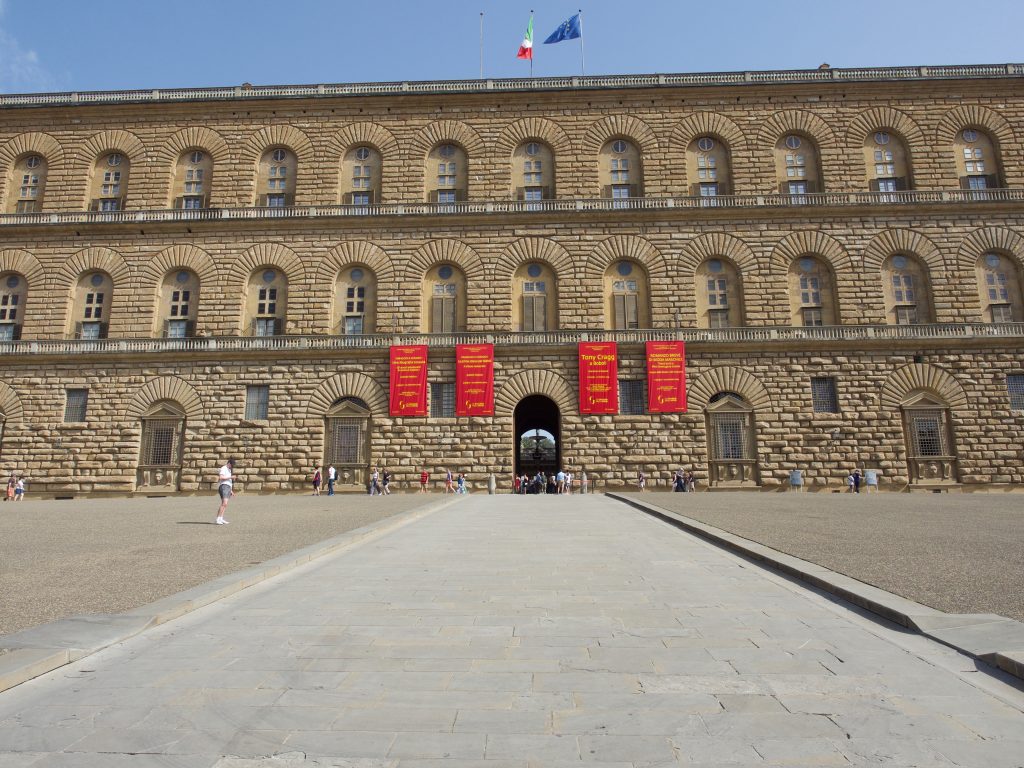
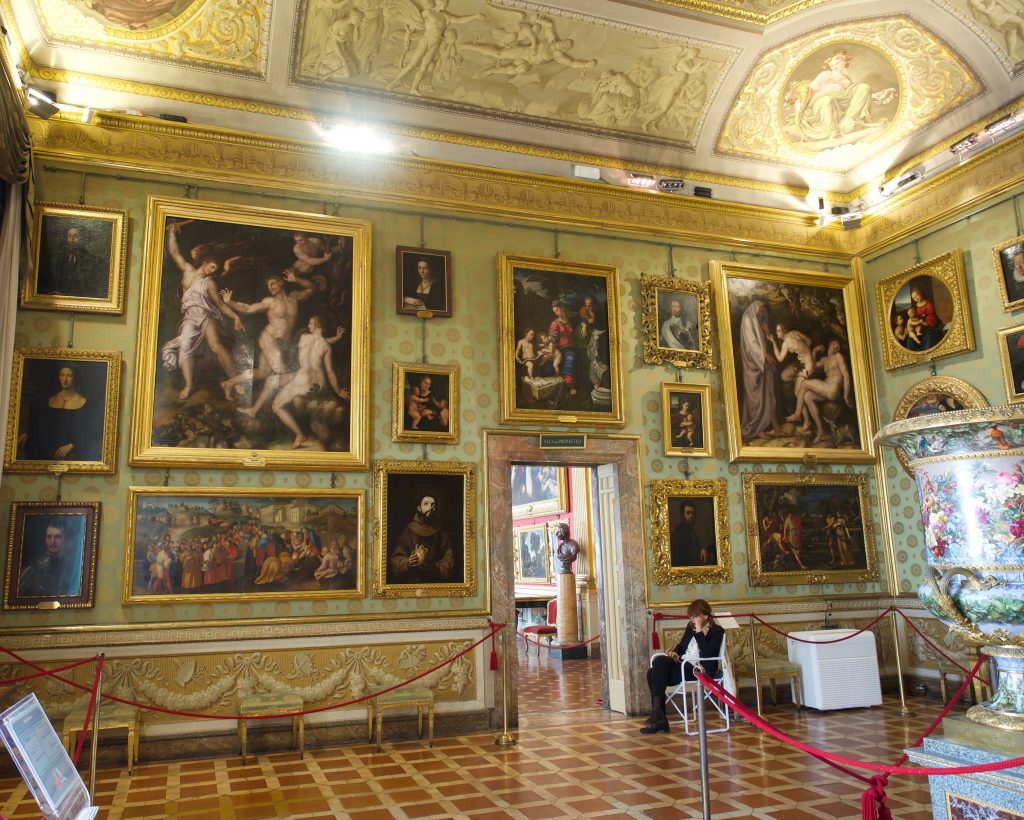
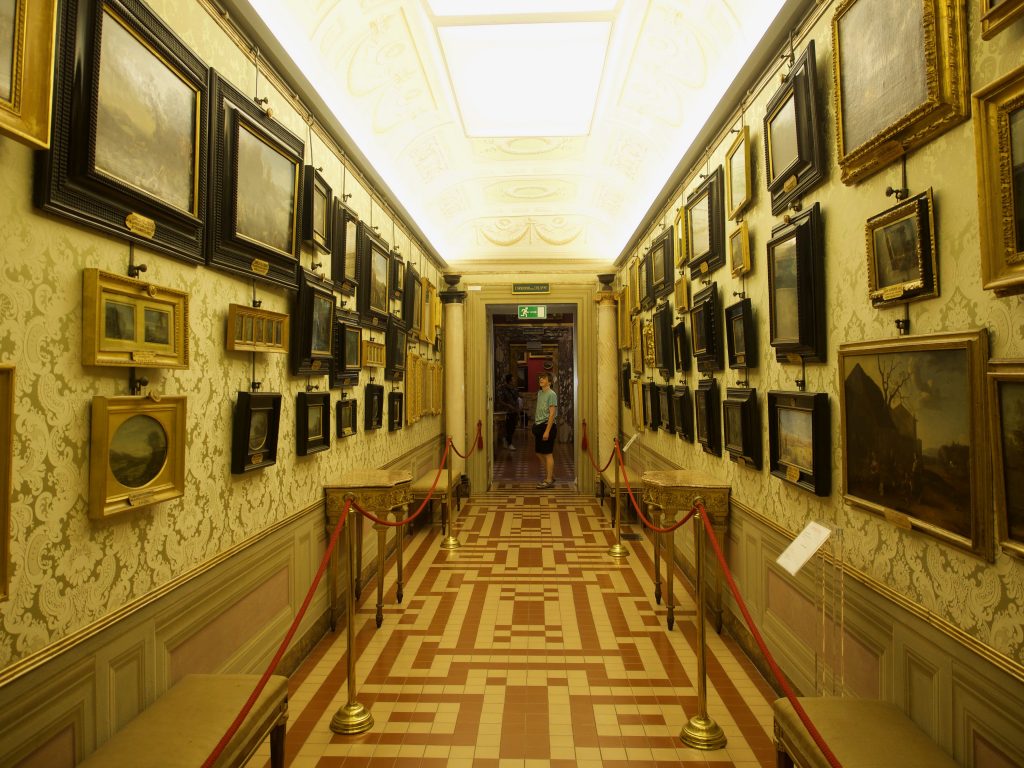
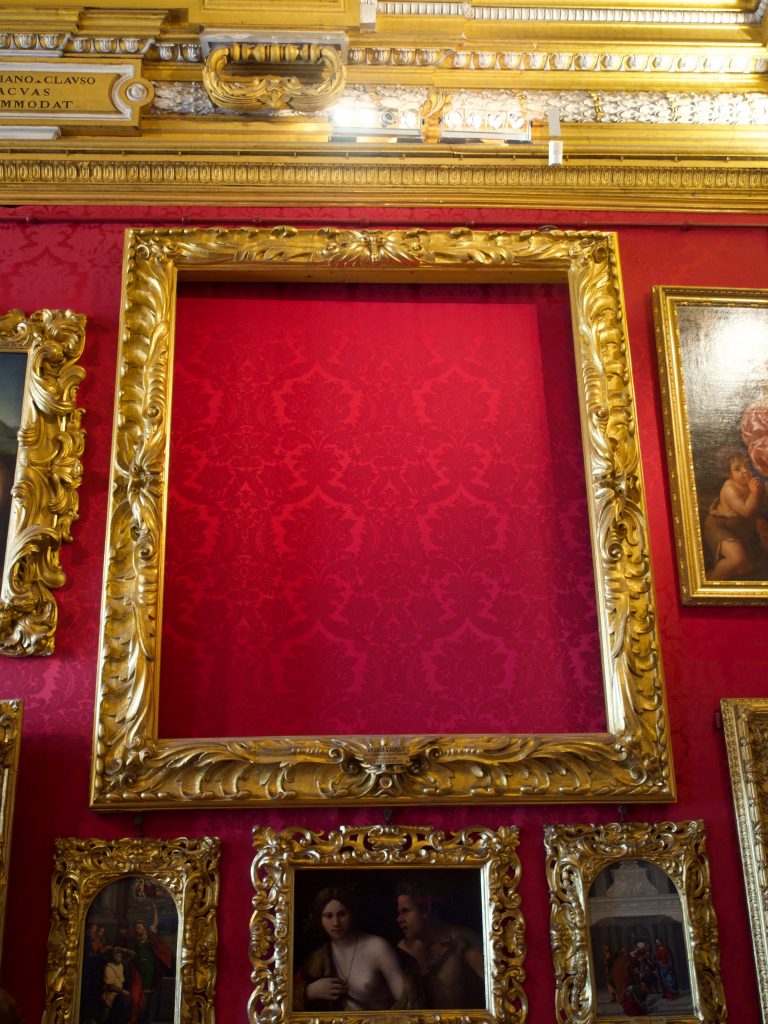
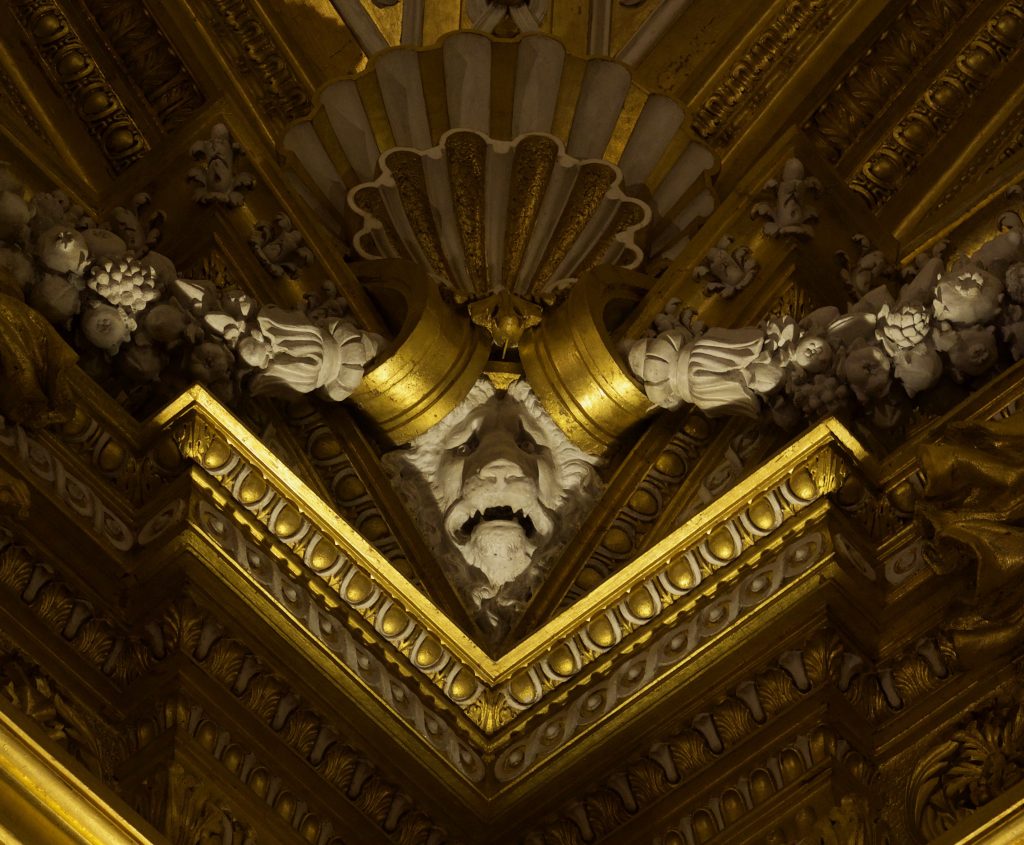
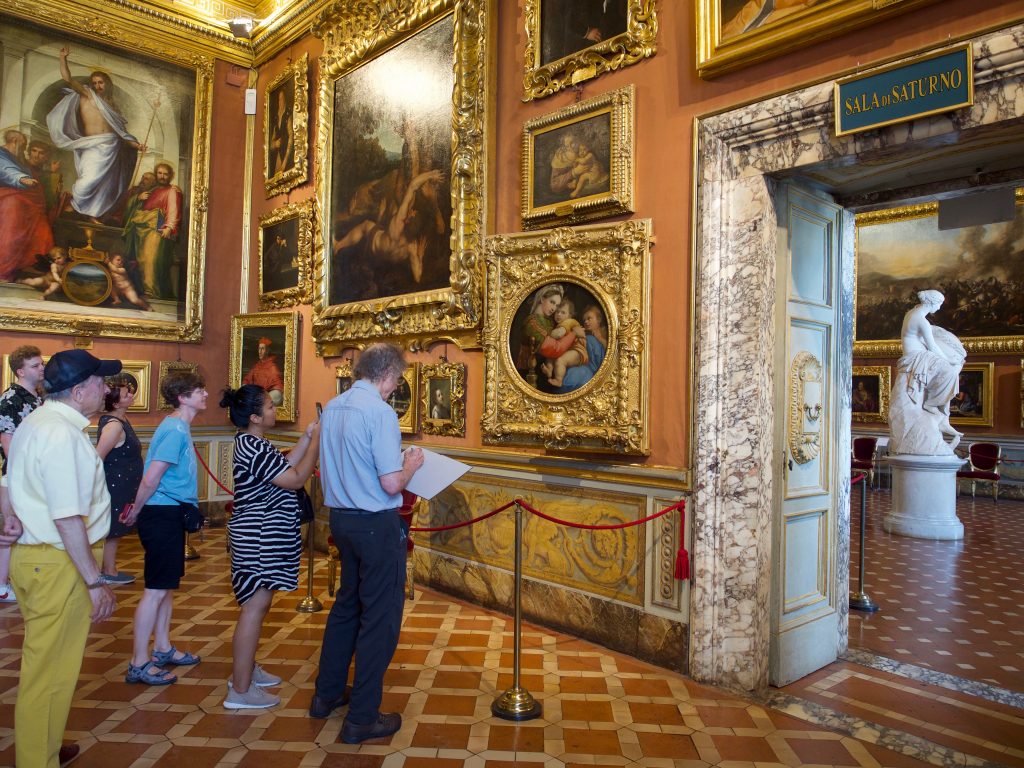
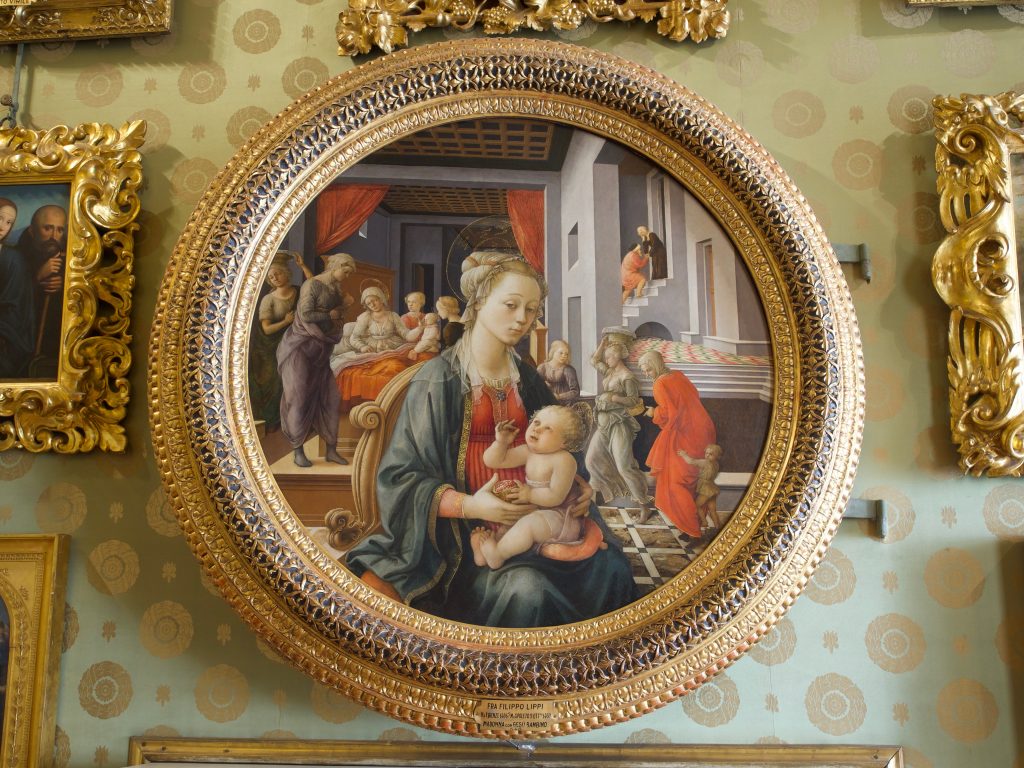
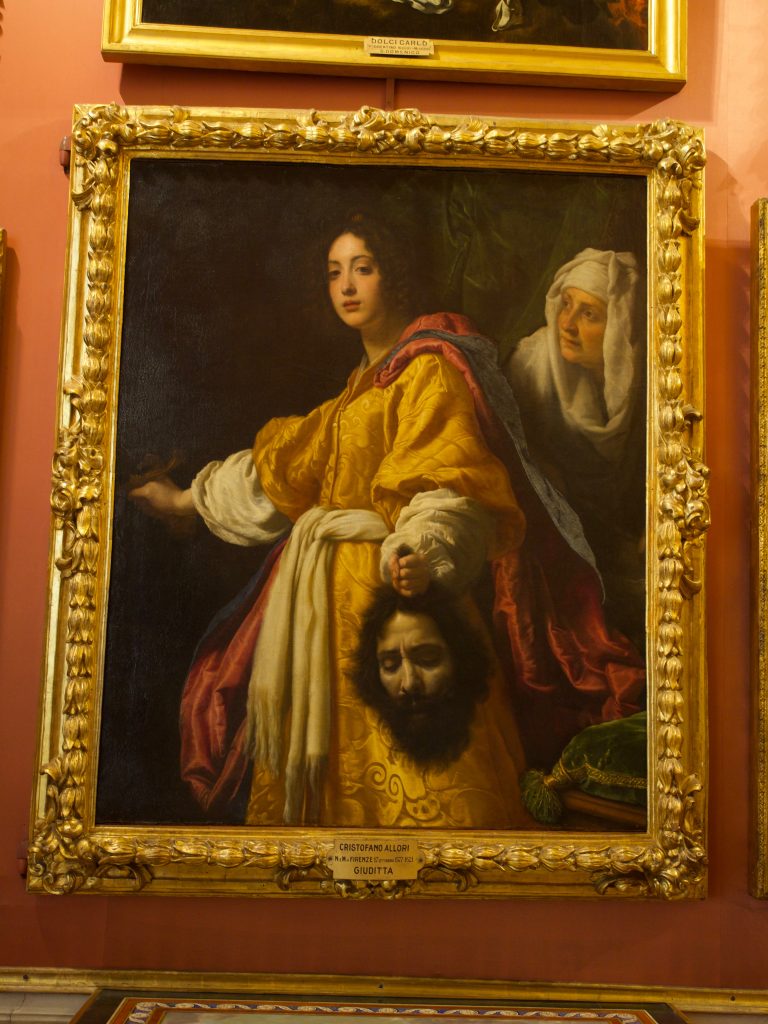
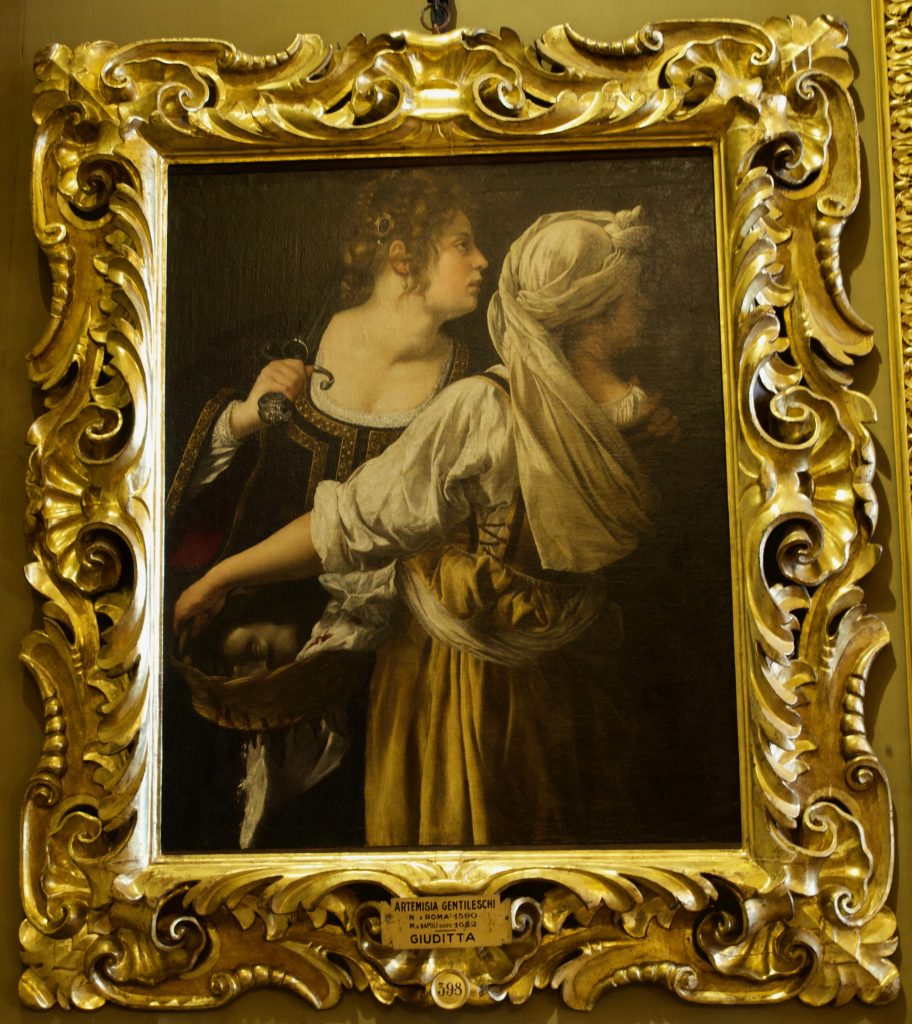
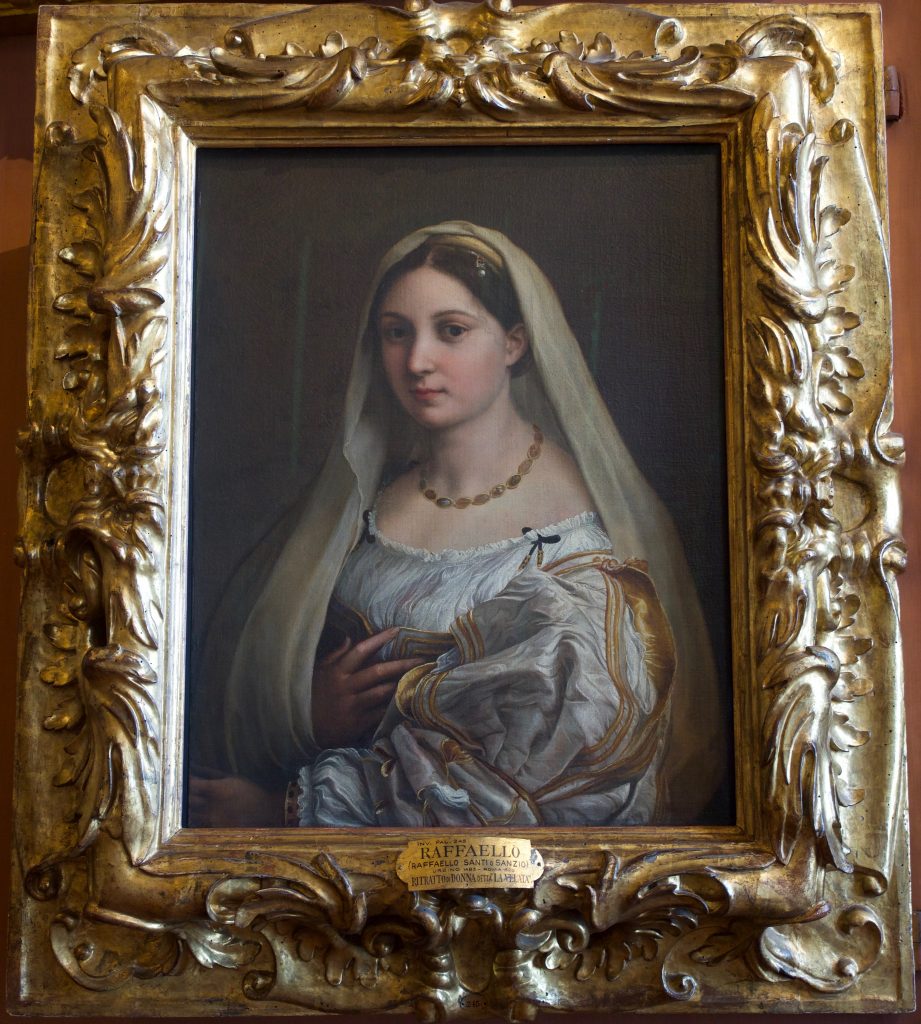
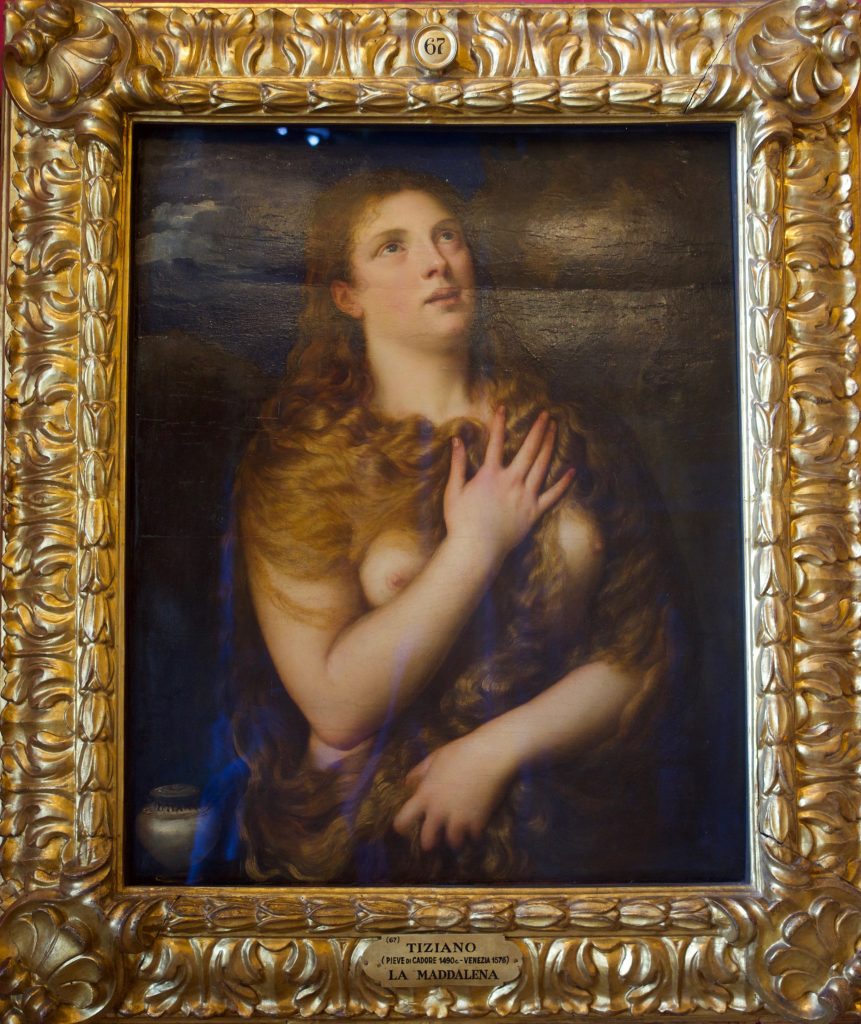
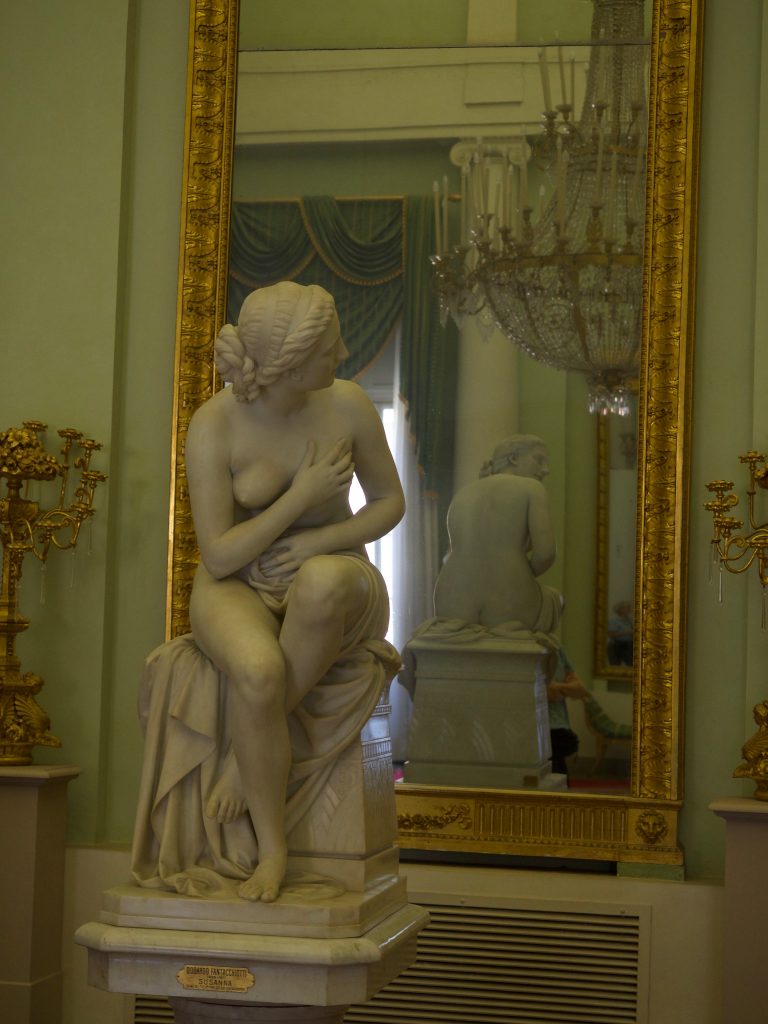
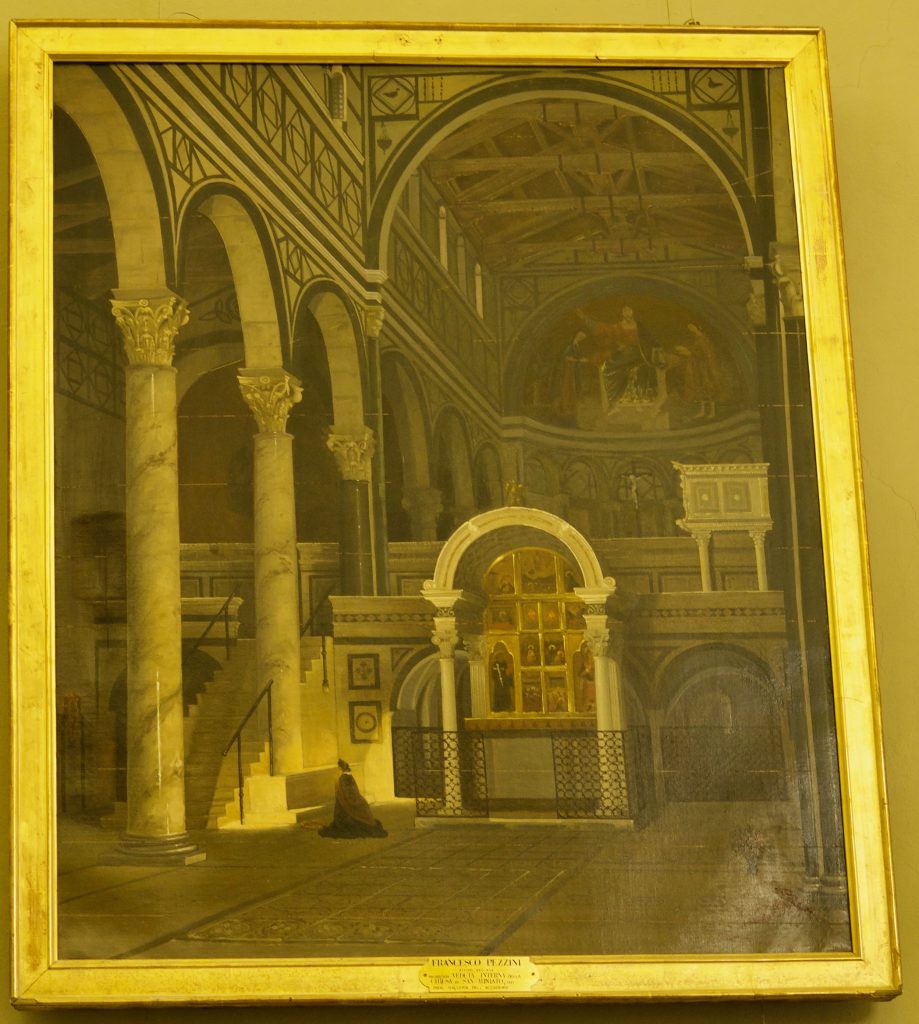
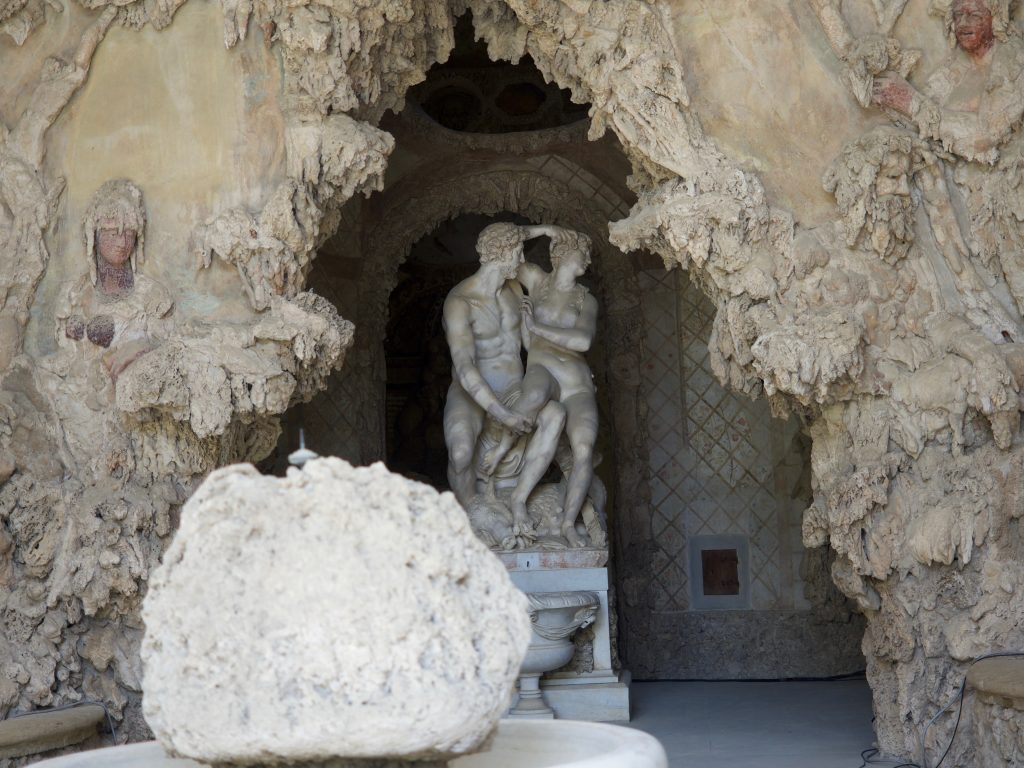
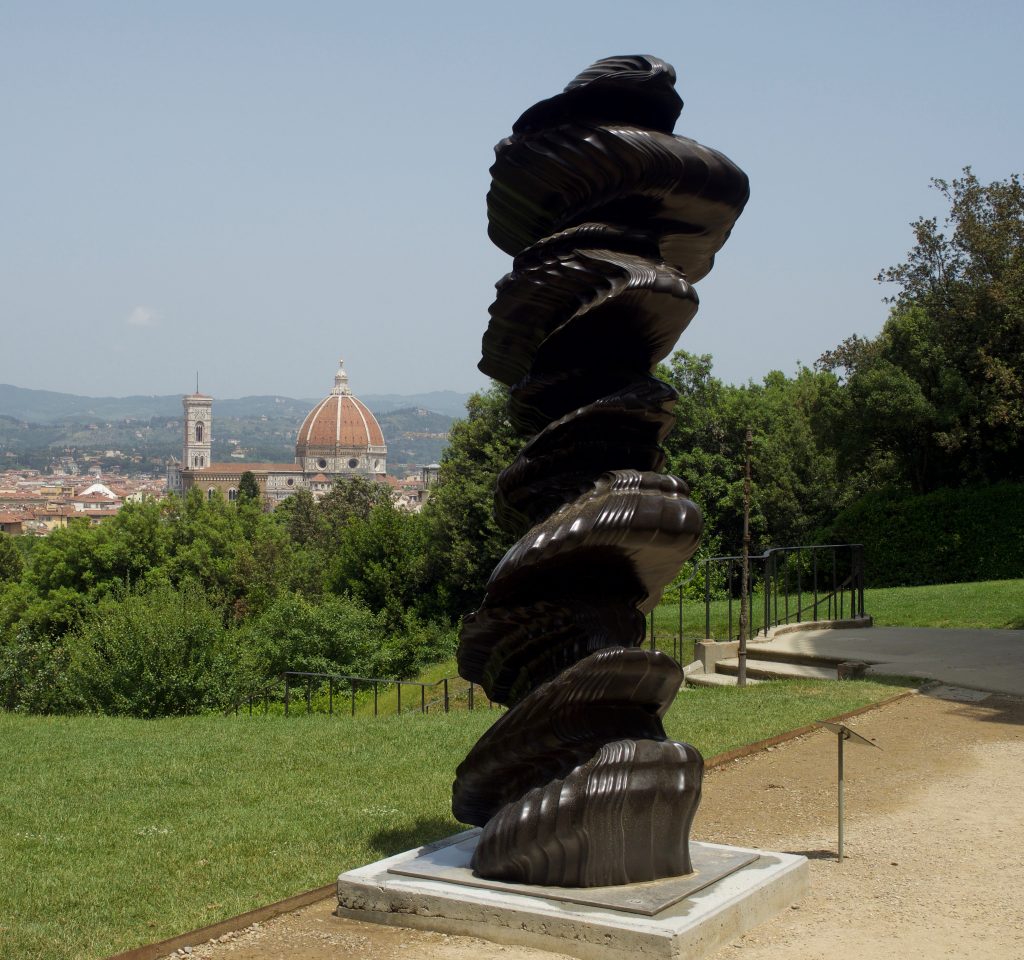
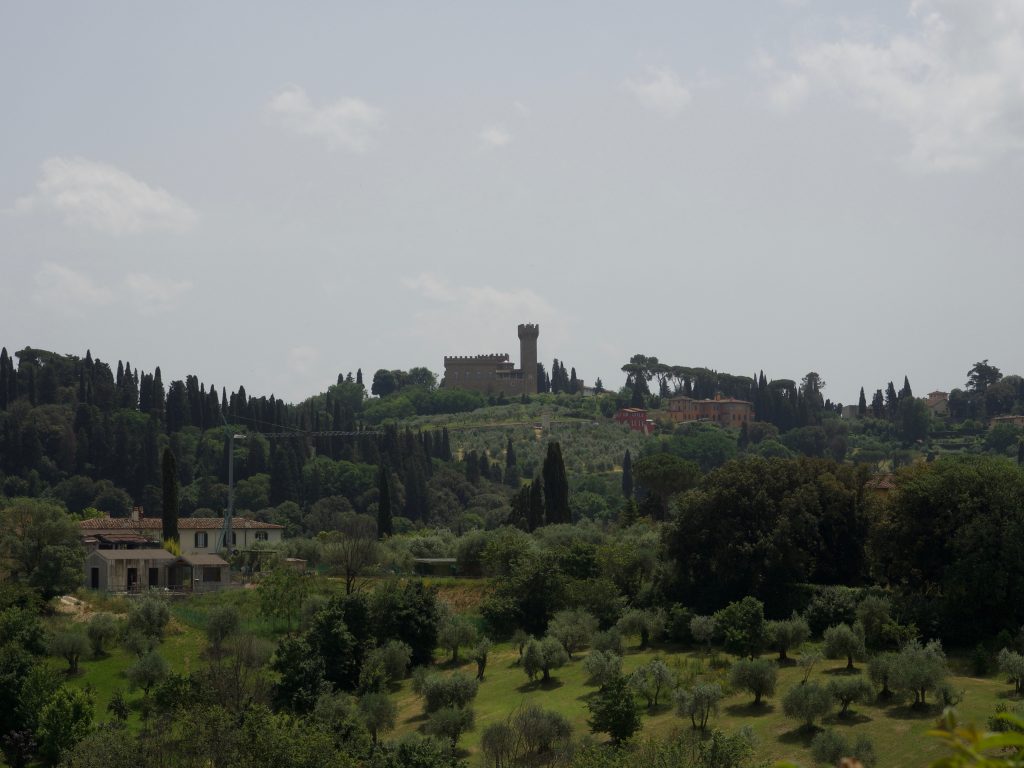
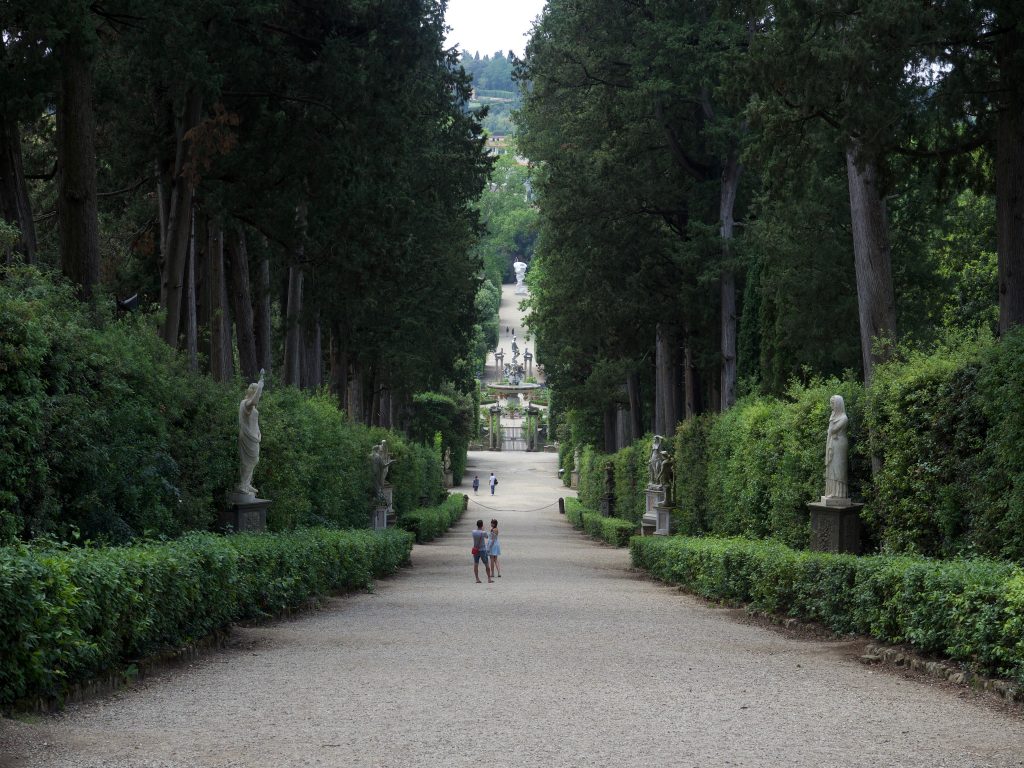
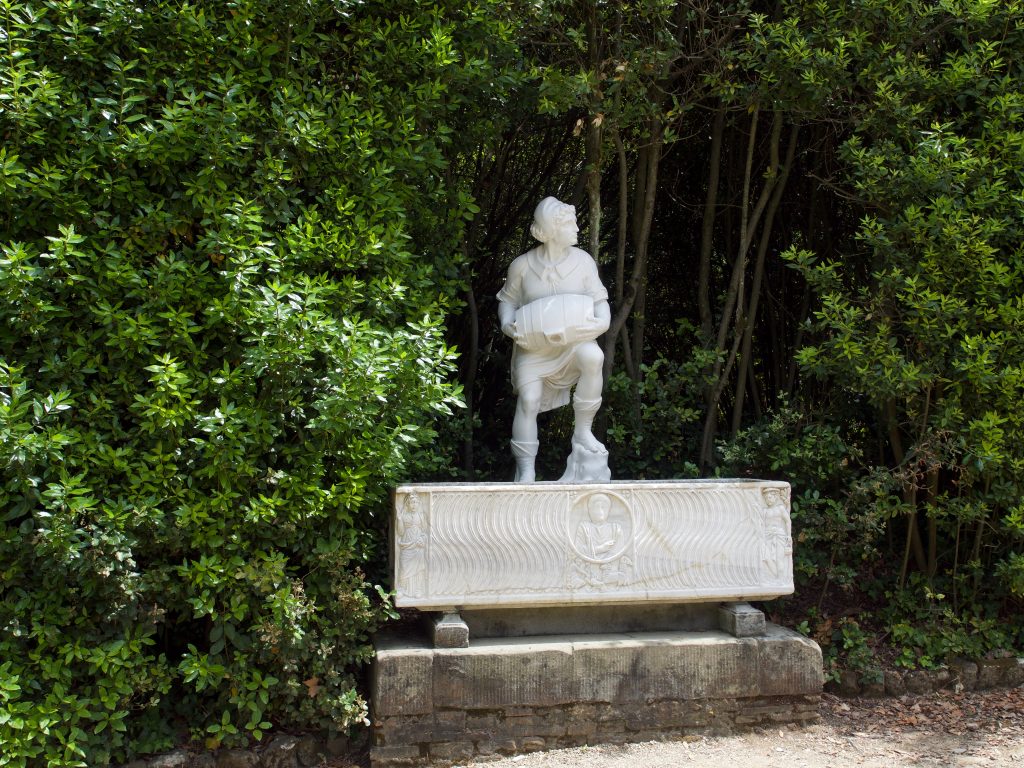
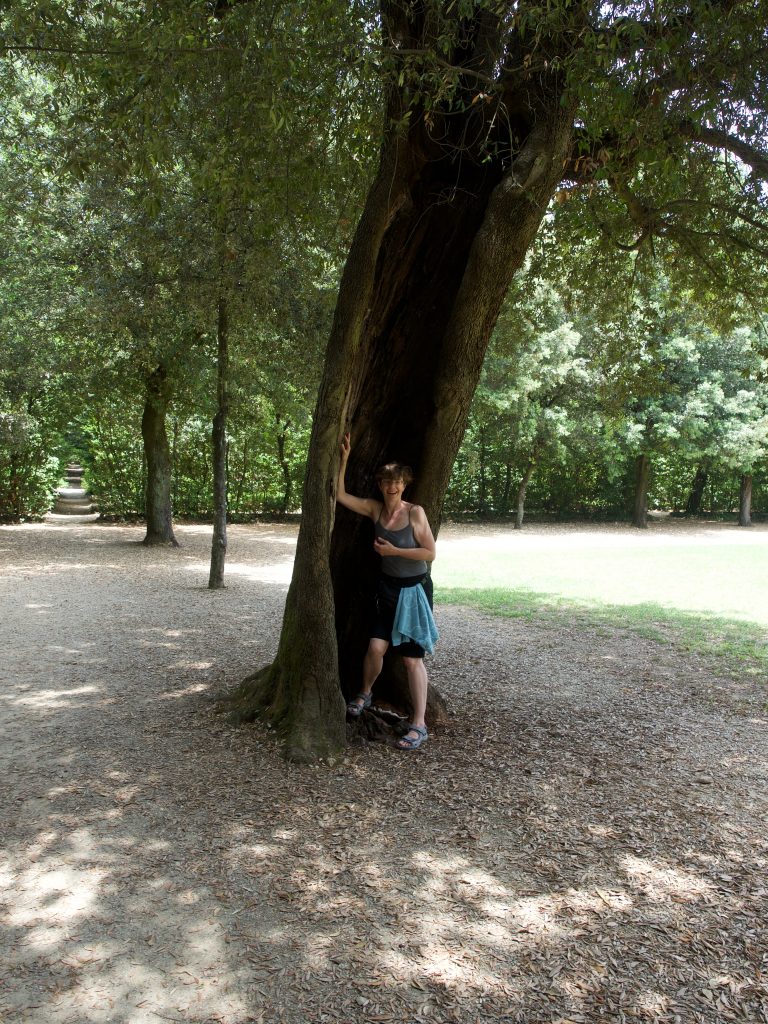
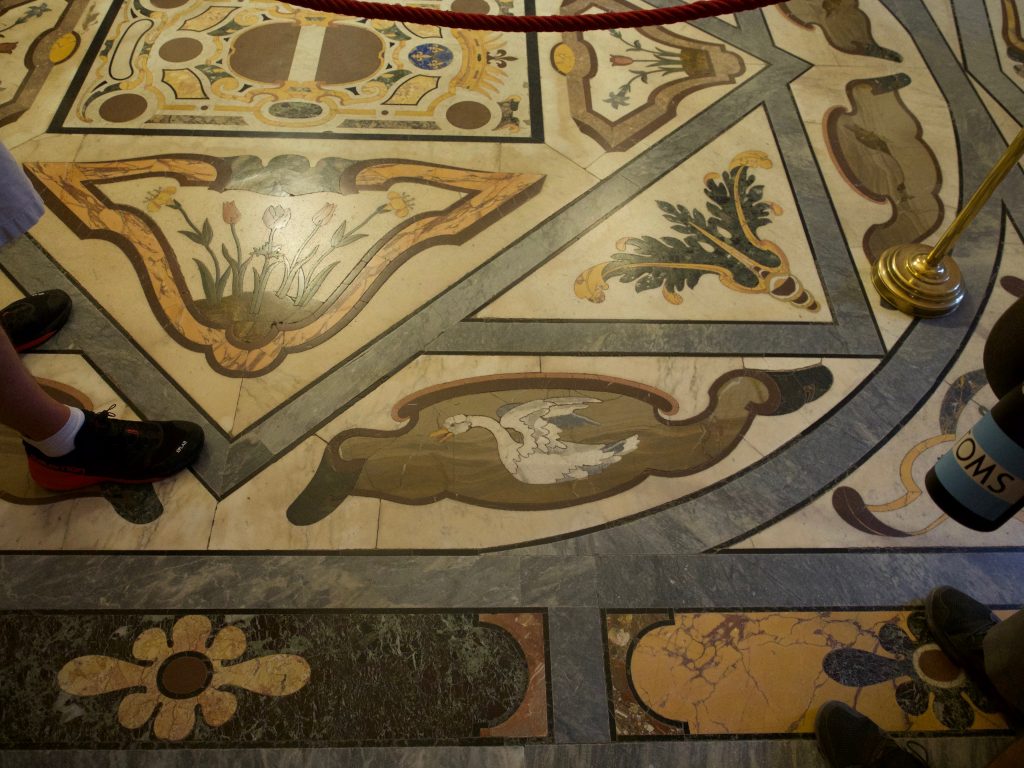
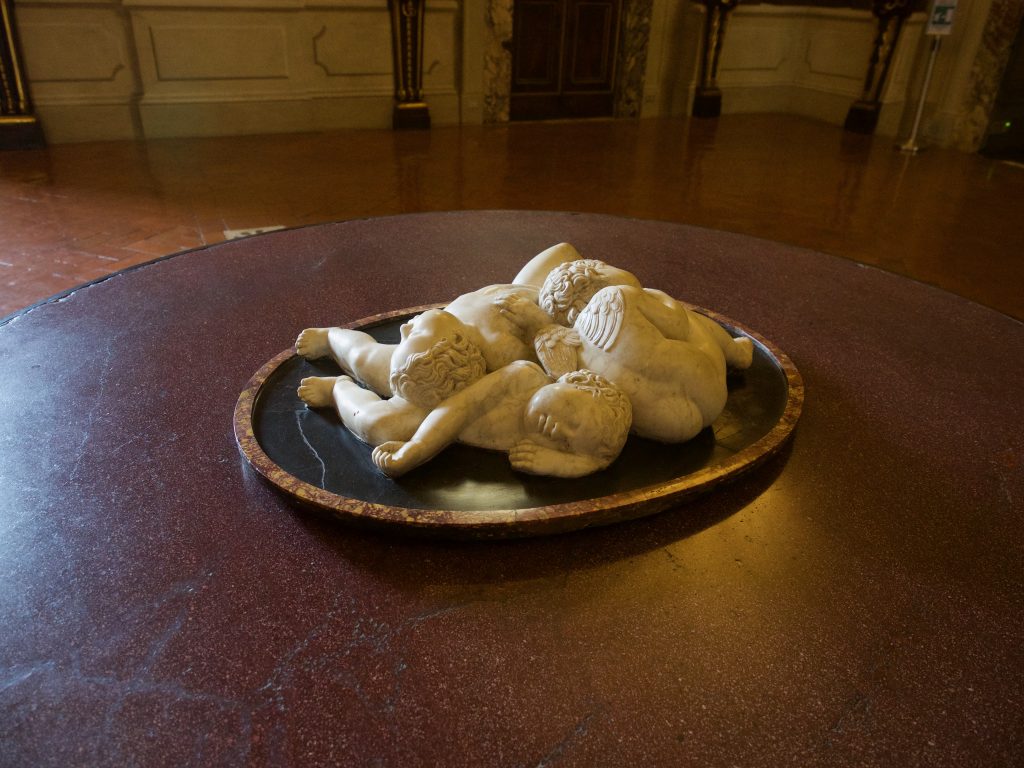
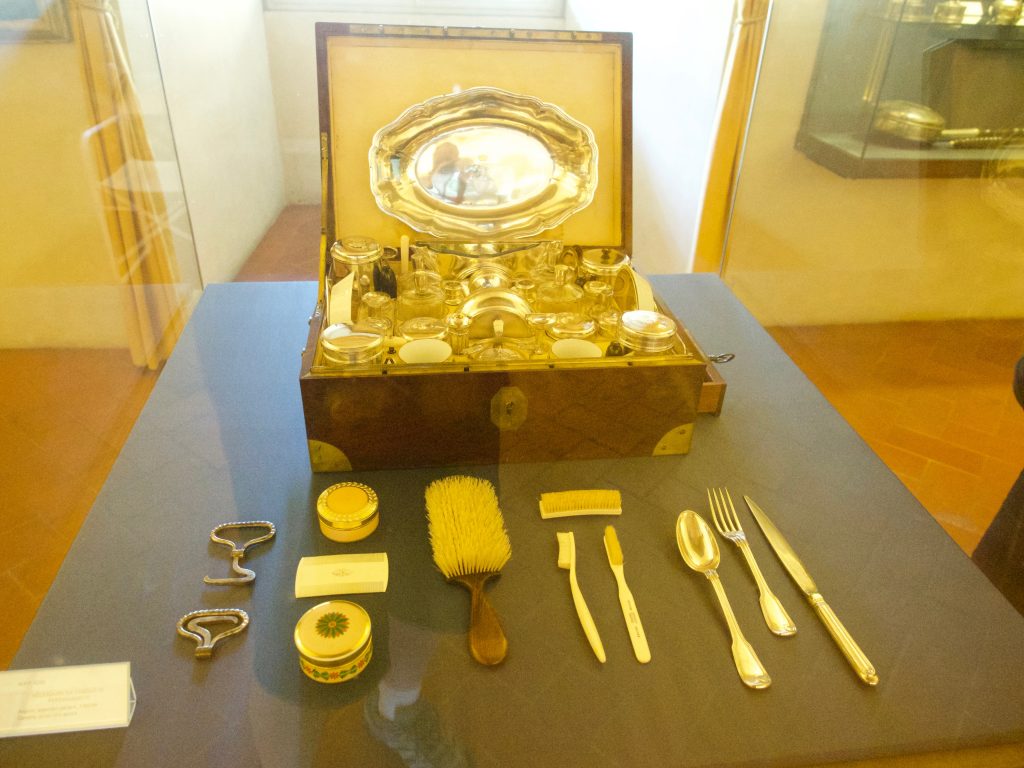
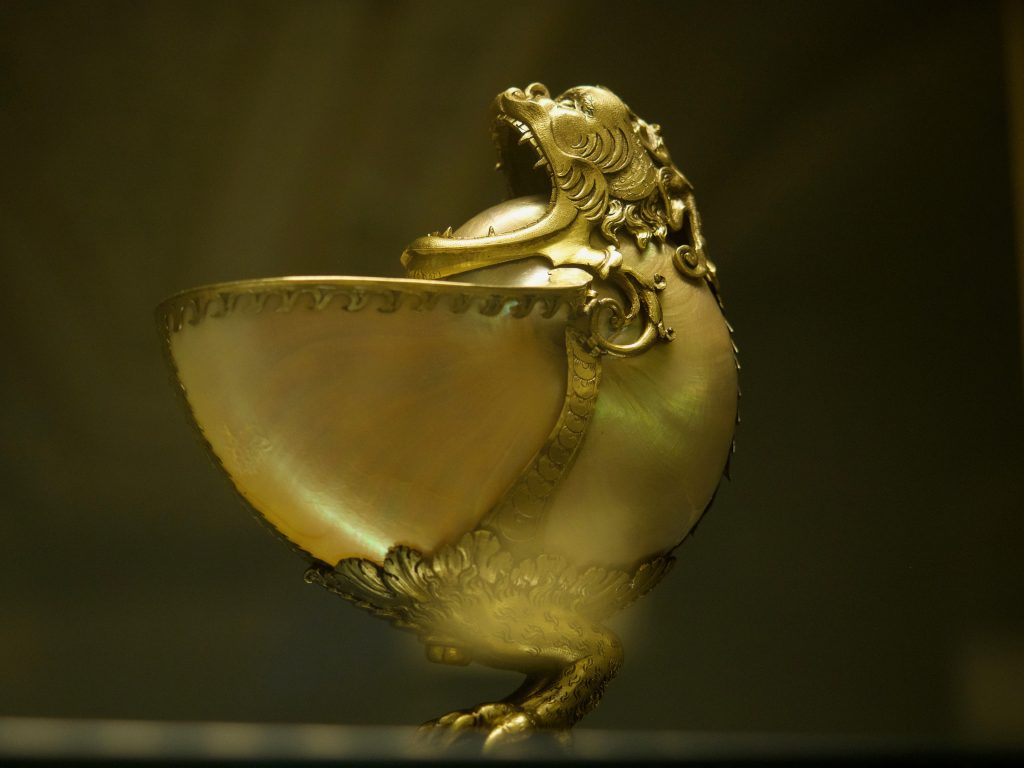
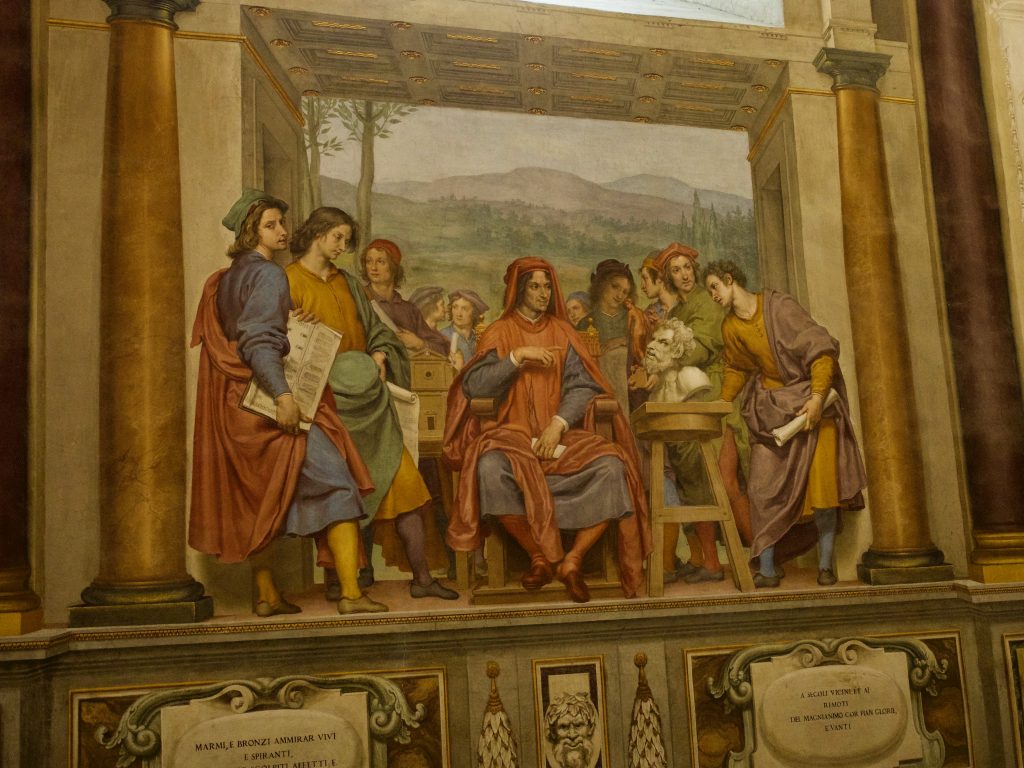
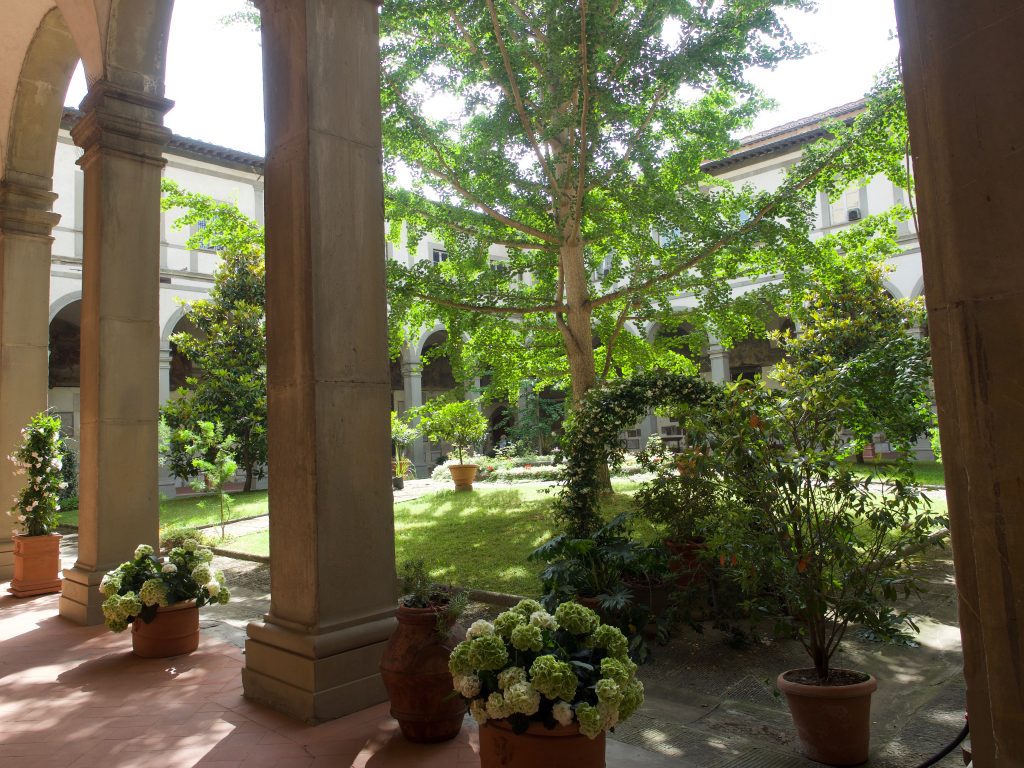
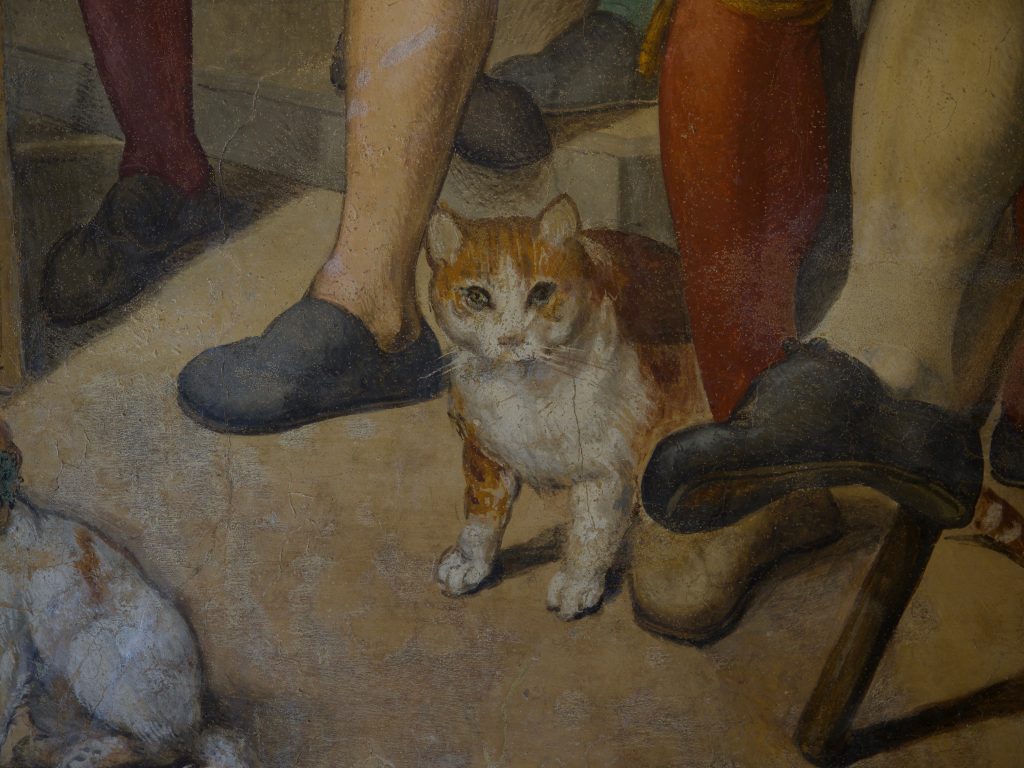
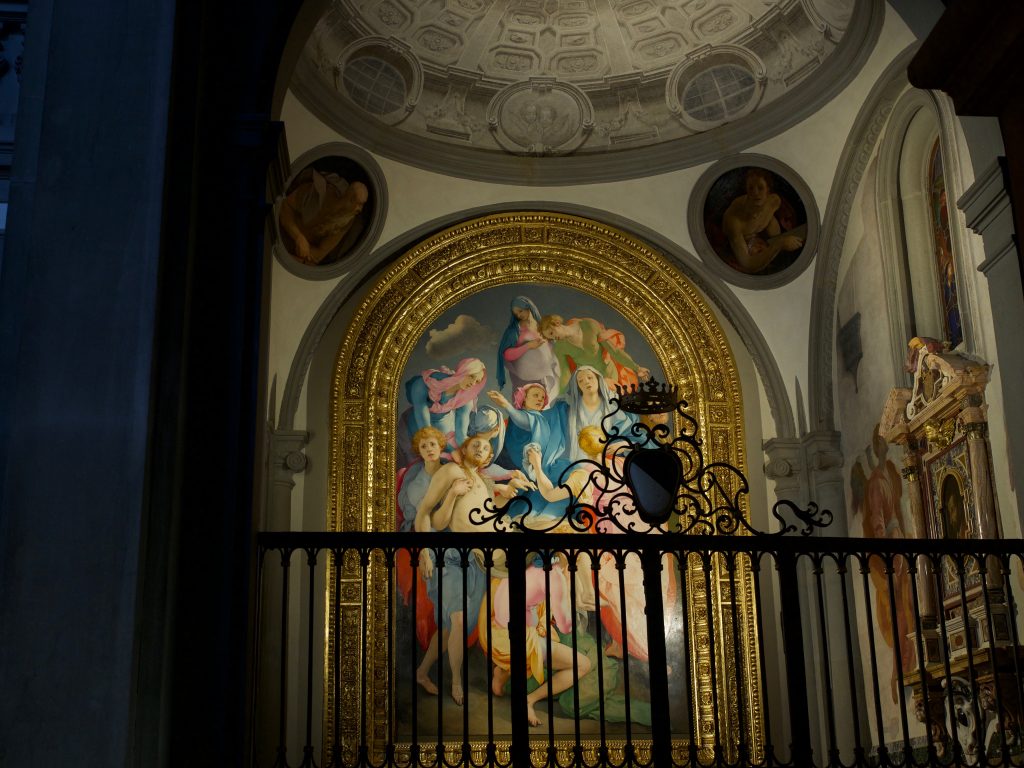
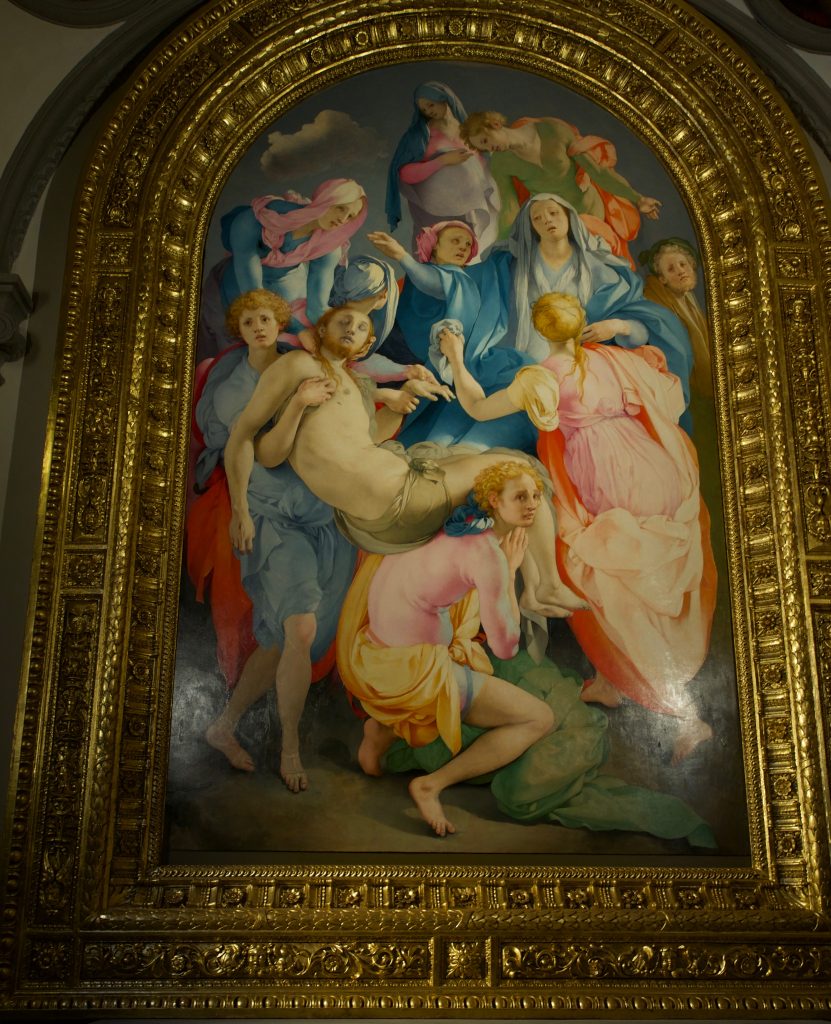
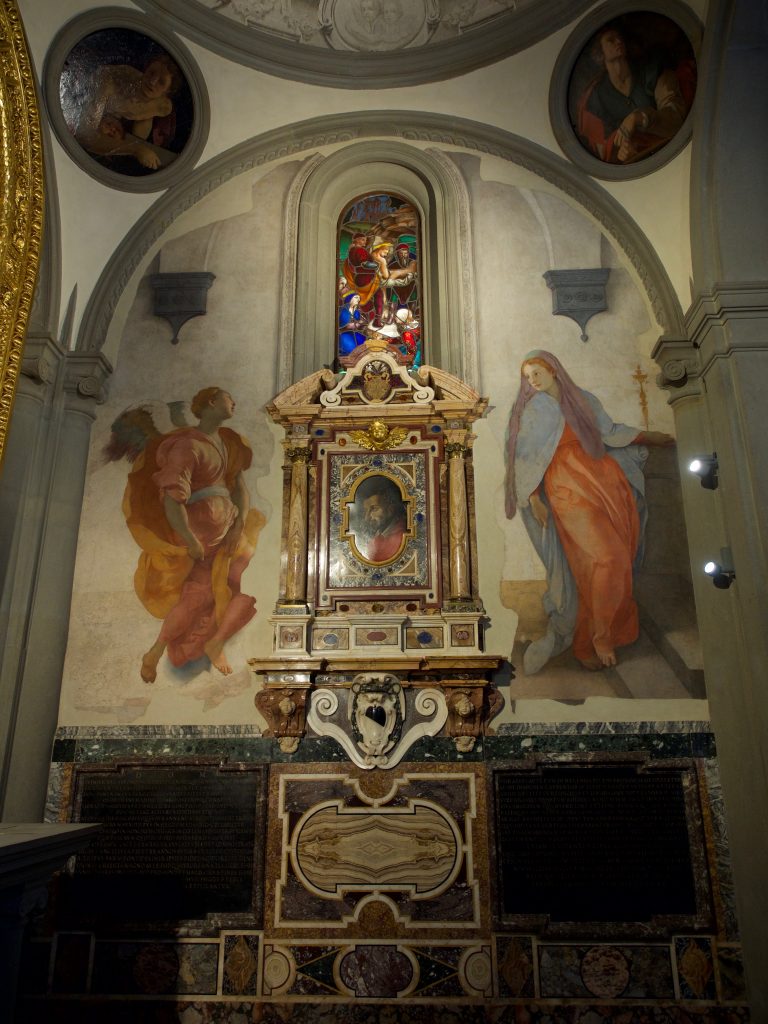
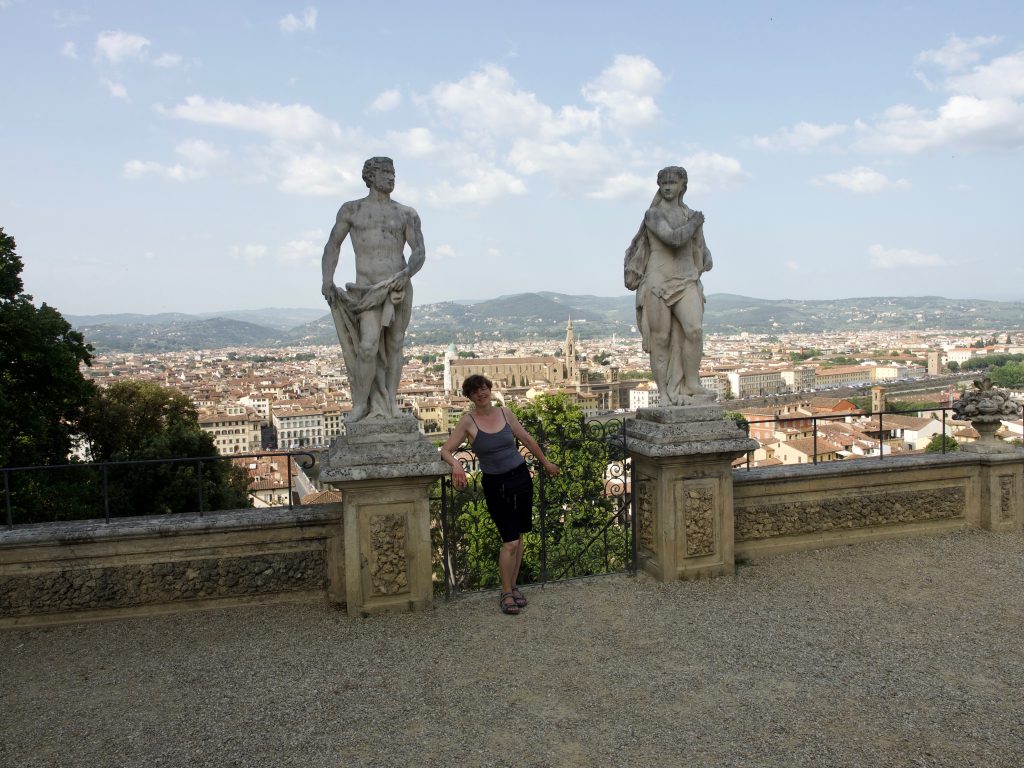
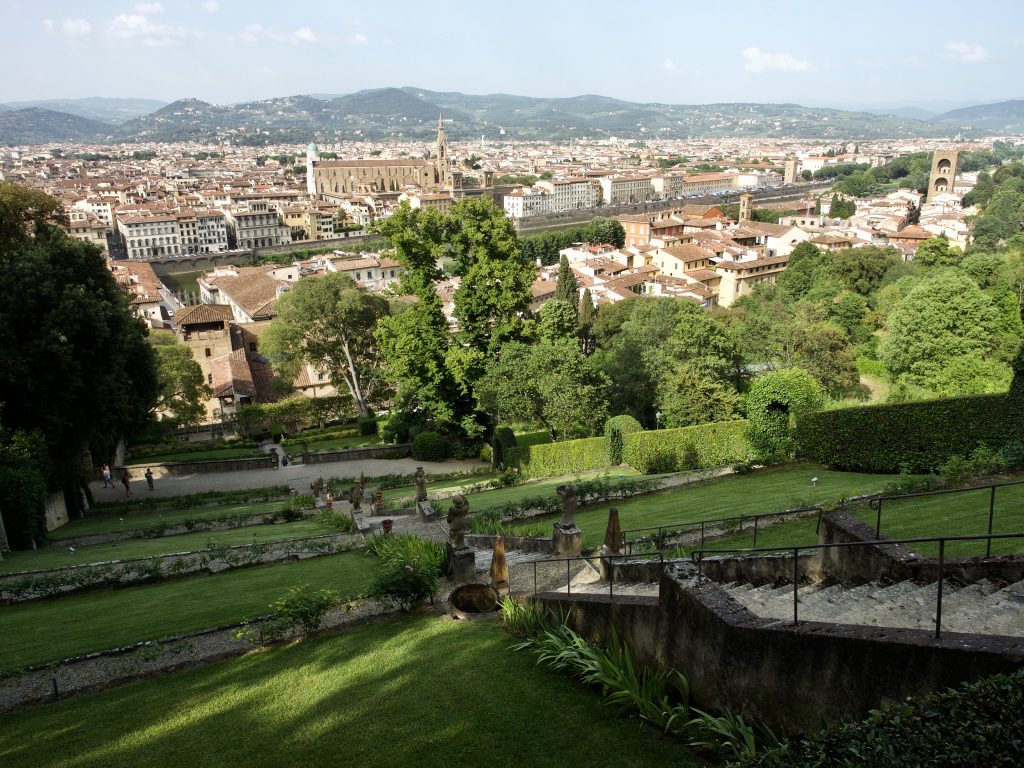
We extended our Florence cards for an additional 48 hours (at 28 euro a piece, we’ll get our money’s worth out of that) and after a quick breakfast, went to see more paintings and some green outdoor stuff at the Pitti Palace, just before 9 am. It was pretty quiet all the way around, given that the tourist magnets are on the other side of the river and take everyone’s main energy. But there was a lot to see!
The Pitti Palace is an enormous building that is externally fairly unified in look with its three tiers of sandstone and its beautiful courtyard, but since it was added on to many times after its original commission in the 15th century, and used by many different rulers from Duke Cosimo I in the 16th century to the end of the Medici family, and then by Napoleon and then by the Kings of Savoy, it is stylistically a complete hodgepodge in style on the inside. The Palace also houses a whole bunch of different museums (5 in total, 4 of which were open), plus the gardens. Thankfully, each room in the museum of most interest to us, the Galeria Palatina and the Appartementi Monumentale had an overview display that just told us when it was renovated by whom (typically late Renaissance, then baroque, then 18th century, and then once more after Napoleon left), and then separate laminated “menus” to pick up with explanations of all the paintings in each room, wall by wall.
Even just looking at the most relevant pieces for my purposes (including the good dozen Eliot rattles off as having seen here) was mind boggling, especially since this museum preserves the old-style “wallpaper display,” with paintings in two and three rows all over the walls plus the distracting decor, including frescoes and stucco above, some baroque, some 18th century neoclassical, some 19th-century neoclassical copy—and only one room still really preserved in the style of the Renaissance. This was a really interesting contrast to the Uffizi in that this is still all being displayed the way it would have been in the 19th century (and in some cases since the 18th), as obnoxious and distracting as the “look at everything we OWN because we are rich and powerful” approach to art display is. Great food for thought when it comes to the evolution of the modern museum, and the ways in which the Uffizi, but not the Pitti, has evolved.
Unsurprisingly, then, the rooms were mostly unappealingly kitschy with their over-the-top mythologizing thematic frescoes above, stucco and other gee-gaws everywhere, and aggressive red and green wallpaper. And as Mark noted, there were none of the world’s most famous “everyone knows about them” pieces that he’s now gotten to see at the Vatican and the Uffizi and the Acaddemia, like the David and the Botticelli Venus. But some of the second-most famous artworks mixed in with the piles of third-tier stuff was truly impressive. Highlights for me (not unique in any way): A beautiful tondo of a Madonna and child by Fra Filippo Lippi, the most beautiful Lippi I have seen so far; Caravaggio’s fat little Sleeping Cupid and a lot of cool Titian portraits, including a Magdalene with the long hair strategically distributed everywhere EXCEPT over her breasts.
The room with the many Raphaels (the Sala di Saturno) was especially crazy, probably with 10 of them in total, many mentioned by Eliot in admiration. Several smaller Madonnas and amazing portraits (I tend to like them way better than the sugary Madonnas), including one portrait I had never seen before, of a woman known as “La Velata.” And even though the crowds were not bad at all and the big tour groups few and far between, the tourists were interesting in their tourist ways; we even caught a guy sketching one of Raphael’s Madonnas, a tondo that a lot of people were admiring. Rubens’s amazing Consequences of War is here was there, but it was so high up and in such a bad position vis a vis the windows that we could not get a good photo at all. That was a little sad, because it is a really intense Rubens piece, and of more interest to me than the portrait of him with his brothers, which was much easier to see. I did find another couple of Artemisia Gentileschi paintings, and her “Other Judith,” with the head of Holofernes already in her basket is good, but a bit tame in comparison with the Judith-in-action painting. And of course I was able to add more annunciations to my image collection. I am still not sure whether that is going to be of any use, but I can’t pass up the opportunity for Mark to collect them for me.
In the second Pitti museum, upstairs, were the works by Florentine artists from the 18th to the late 19th century, which were of lesser interest to us, but there were a few genre scenes we really liked, for example a series of paintings set inside of San Miniato al Monte that were very recognizable as “Florentine,” of course. I also discovered a couple of more in the same manner by Odoardo Borrani, who had done the women visiting the Accademia, and also has a painting of a nun praying at Bernini’s St. Teresa in Rome, which is PERFECT for my purposes, especially if I write about St. Teresa next semester. He also has a medieval scene that we thought was set at the city gate to the east of us, the one leading to Pisa, that we went to the other day. The Florentine late realists and impressionists, the Machiaoli, were well represented here with contemporary portraits, landscapes, and historical paintings, but I know next to nothing about them (just as Eliot completely ignored them). There was also a small collection by a female painter from the early 20th century that was very interesting—as well as a number of scattered female artists throughout—not much but at least they clearly made an effort!
Once we had quickly toured the second floor, we went down the imposing grand staircase back to the courtyard and had an unimaginative lunch at the cafe (a pizza and a Greek salad). Then we explored the Boboli gardens, even though it was quite hot (probably near 90, and humid). This pre-Versailles Renaissance / Baroque garden had everything you would imagine, including ridiculous grottoes created with upside-down coral to suggest “stalactites,” vast geometric designs, and shady walkways, but also some surprises: some pretty mossy but still mostly intact statues that have been there since the 1700s, and the statue of a peasant with a barrel near the entrance by the Roman gate of Florence that has actually recently been replaced by a replica, while the real piece is inside the Pitti palace, carefully restored, as the first statue to ever be commissioned specifically for the gardens in the 1550s, and unusual in that it was of a working man. And then there were many cleverly positioned monumental works by Tony Cragg, a well-known and highly lauded, recently knighted contemporary British sculptor (whom I did not know, embarassingly), to whom the Uffizi is hosting a special retrospective throughout the park. The message of the placement was very effective: here is a master of modern, abstract sculpture, and if you can see his columnar pieces with the Duomo behind it or at the end of a palatial garden walk, you see them as the work of today’s Michelangelo, basically.
From the very southern edge of the park, where a palace building now houses a porcelain museum, we could see out into the hills and to what we determined was the Torre de Gallo, a view into the back country that we really haven’t had from anywhere else. Otherwise, our main goal while walking through the gardens was to keep in the shade in bowers and tree-lined alleys, because it was quite hot. But it was still nice to be among green things and see into the far distance and across all of Florence after all that indoor stuff. Eventually, though, we went back into the cool indoors, and “did” the last museum on our ticket, the “Treasure of the Dukes,” predictably all the gold and jewelry and other collectibles from ivory figurines to antique agate cups doctored up with Renaissance gold decor, all in yet more sumptuous, overdecorated rooms, including one with one of those crazy baroque illusionistic ceilings that seem to go far beyond the actual ceiling. Some things were very weird, like the roundel of putti set flat onto a marble table that we immediately christened “Babies for Dinner,” a “picnic basket” for princely traveling mostly consisting of silver dishes, the nautilus shells made into drinking cups with elaborate goldsmith work added to them, rainbow-colored jasper dishes and vases made entirely out of carved rock crystal. There was also the Salon of Giovanni da San Giovanni, an artist I had never heard of; he was not particularly good but I liked the “comic book” effect of the the enormous room, designed as a tribute to Lorenzo di Medici for a 1635 wedding of a Medici to the last heir of the Dukes of Urbino. The allegorical representation of the barbarians of the Middle Ages (as centaurs) kicking out art and knowledge, which are then brought back with the help of Lorenzo in Florence as the new Athens was told in multiple “panels” wall by wall, and the propaganda aspect was highly entertaining, with red-clad Lorenzo with his hero cape doing All the Things for the arts, including sitting in judgment on a bunch of sculptors, architects, and painters in my favorite panel, on the window side.
Eventually, though, we left and visited one more church on the Oltrarno side, Santo Spirito. This is another church with older roots and a (SIMPLE) baroque facade, but a beautiful interior designed by Brunelleschi, with a beautiful dome, where Mark shot from the hip, because we were not really supposed to take photos. It has Michelangelo’s possible early wooden cross in the sacristy, and a beautiful cloister, complete with very decayed frescoes, with an incredibly peaceful fountain and tree in the center. While a second cloister wasn’t open to from where we were, we could visit a chapterhouse and a newly restored refectory with a triple New Testament “food fest” for the monk’s cafeteria, as it were: the Wedding at Cana, the Last Supper, and the Supper at Emmaus (the latter including a cat—we do collect cats in paintings, just as a sideline).
Then we walked by a church that we had noticed before when it was closed and when we could just see that the Vasari walkway from the Pitti to the Palazzo Vecchio led toward it. The name, Santa Felicita, had not rung any sort of bell, and we were just taking a quick peek at it all around; it seemed like just another Florentine Renaissance church after so many others. But (the first time I had seen this outside of Rome), someone threw money into a box to turn the spotlight on to illuminate the side chapel on the right at the entrance—and there it was! I had completely forgotten that this is the church where Pontormo’s Deposition is in situ, now lovingly restored and looking like it was painted yesterday. This is from the late Renaissance, a mannerist work that is very much post-Michelangelo, so I should not even be that excited about it, but since I had not just studied this in passing, but read this absolutely brilliant article by the famous John Shearman, the Renaissance art historian who explains better than anyone else why the art SPACE in which we see a painting is so important. That made this painting incredibly special to me, and I felt (and I often don’t) like I UNDERSTAND the painting and what impact it is supposed to have on me as I look at it. In this case, the composition, with a swirl of figures around an empty middle that is left behind because Christ has been taken down (literally from the cross and metaphorically as he is now dead) is incredibly powerful, as is the despair on the faces of the grieving as they look out at you, the viewer. It didn’t even bother me that we as modern viewers were actually kept out of the space where John Shearman says we should be standing (in the center of the chapel) by an iron gate that keeps us out of the chapel entirely. That actually makes total sense to me symbolically, too, because there is no way I can really get into that “Renaissance space”—as a modern human, as an atheist, and also as someone who cannot turn time back and recreate the chapel as it originally was, before a cupola replaced a vault with a lunette of God the father across from the deposition (as John Shearman found out as he researched the piece). It was just amazing to see it and it made so many things about space really click.
The Bardini Garden was our last stop, a much smaller but beautiful old garden straight up the hill (more uphill walking!) from the Via de Bardi on the way home (maxing out the FirenzeCard!) that was a lot of fun to ramble around in, because it is only very slightly restored, mostly with attention to the gardening itself. The statues and mosaics and a random grotto were all very low key, and that was a nice wrap-up to our day. We had another lovely dinner at home, worked on our photo/blog project, briefly went out for an evening walk (clouds & no sunset today, but all kinds of extra activity and glittery things because of that stupid fashion show, Pitti Uomo Imagine). We actually forewent our evening gelato because we didn’t walk by any appealing gelato places, and because we had gotten badly burned near the Pitti, where a marginal gelato with two flavors ended up costing 5 euro, when it’s normally between 2.50 and 3.00. I was so mad at myself for not asking about the prices first, as we usually do! We instead went home and had a cookie and fizzy lemonade, and worked on our blog logistics until almost midnight. The fear of having it all fall out of our heads if we don’t write it down (me) and sort the photos and upload them (Mark) is driving us!